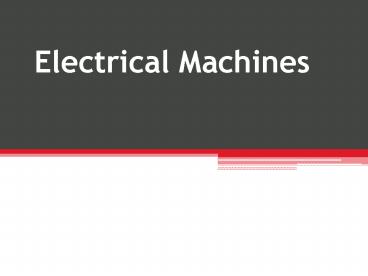Electrical Machines - PowerPoint PPT Presentation
1 / 32
Title:
Electrical Machines
Description:
Electrical Machines LSEGG216A 9080V Why do we laminate the core? Why do we laminate the core? Why do we laminate the core? Losses due to Eddy Currents Grain ... – PowerPoint PPT presentation
Number of Views:160
Avg rating:3.0/5.0
Title: Electrical Machines
1
Electrical Machines
- LSEGG216A
- 9080V
2
Content of Course
- Transformer Construction
- Transformer Operation
- Transformer Losses, Efficiency Cooling
- Transformer Voltage Regulation Impedance
- Parallel Operation Auxiliary Equipment
- Auto Transformers Instrument Transformers
- 3? Induction Motors Operating Principles
- 3? Induction Motors Construction
- 3? Induction Motors Characteristics
- 1? Induction Motors Split Phase
- 1? Induction Motors Capacitor Shaded pole
- 1? Motors Universal
- Motor Protection
- 3? Synchronous Machines
- Alternators Generators
3
Assessment
- Theory Test 1
- Theory Test 2
- Practical Test
- Quizzes
- Theory Test 3
10 15 25 10 40
MUST PASS
4
Transformer Construction
5
Introduction
- Describe the construction of the various types of
lamination style and core construction used in
single phase, three phase, auto and instrument
transformers. - Identify the different winding styles/types used
in transformers. - State the methods used to insulate low and high
voltage transformers. - Describe the construction of transformer tanks
for distribution transformers. - List the types of information stated on
transformer nameplates. - Perform basic insulation resistance, continuity
and winding identification tests
6
Transformer Uses
- Changing
- Isolation
- Voltage Levels
- Current Levels
- Impedance values
7
Transformer Operation
- Primary coil is supplied with a AC voltage.
- Current drawn produces a magnetic field
- Magnetic field transported to a secondary coil
via a magnetic circuit - Magnetic field induces a voltage in secondary
coil
V
V
8
Transformer Operation
- Primary coil normally has a subscript of 1
- Secondary coil has a subscript of 2
I1
I2
V1
V2
9
Core Types
- Core Construction
- Steel type
- Laminations
- core type
- Shell type
- Toroidal
10
Core Type
One Magnetic Circuit
11
Shell Type
Two Magnetic Circuits
12
Toroidal Core
13
Laminations
- Why not just solid steel?
- Eddy Currents
14
Why do we laminate the core?
I
S
15
Why do we laminate the core?
Eddy currents are large losses are great
- Large Number of flux lines cut
- High voltage generated across core
I
S
16
Why do we laminate the core?
Eddy currents are small losses are reduced
- Small Number of flux lines cut
- Low voltage generated across core
I
S
17
Losses due to Eddy Currents
Pe Ke F Bm t1
losses in W/m3 Constant Frequency Maximum
Flux density Lamination thickness
18
Hysteresis Curve
- Bigger the area covered, the more losses
associated with Iron losses
19
(No Transcript)
20
Steel Types
- Silicon steel is used for laminations
Silicon content 0 6.5
Why Silicon?
- Small hysteresis curve area
- Increases electrical resistivity
Reduced eddy current size
- Hardened grain structure
- Reduced workability
- Very low carbon levels lt0.005 are called for or
magnetic ageing will take place
Losses will increase with age
- Carbon can be removed by annealing in a hydrogen
rich atmosphere
21
Grain Orientation
- Optimum properties are developed in the rolling
direction - Magnetic density is increased by 30 in the coil
rolling direction - Magnetic saturation is decreased by 5
- Given codes such as M-0, M1, M-2, M-3, M-4 and
M-6
Non-orientated
- Similar magnetic properties in all directions
- less expensive
- Used in applications where the direction of
magnetic flux is changing (motors and generators) - Given codes from M-15 to M-47
22
Grain Size
- The larger the grain the less the hysteresis
losses
2-10 W/kg _at_ 60 Hz and 1.5 tesla magnetic field
strength are common with a 150µm grain size
heat treatment increases the average crystal size
Excessive bending, incorrect heat treatment, or
even rough handling of core steel can adversely
effect its magnetic properties
23
Amorphous Steel
- losses up to 30 of conventional steels
Made by pouring molten alloy steel on a rotating
cooled wheel.
This cools the metal so quickly that crystals do
not form
- high cost (about twice that of conventional
silicon steel) - lower mechanical properties
24
Lamination Coatings
- Increase electrical resistance between
laminations - Provide resistance to corrosion
- Act as a lubricant during die cutting
- Can be organic or inorganic (such as Magnesium
oxide) - Dependant on the heat treatment of the
laminations - Wheather it is immersed in oil
- The working temperature of the finished item
25
(No Transcript)
26
Magnetostriction
- A property of ferromagnetic materials that causes
them to change their shape when subjected to a
magnetic field
first identified in 1842 by James Joule
When a magnetic field is applied, the boundaries
between the domains shift and the domains rotate,
both these effects causing a change in the
material's dimensions
losses due to frictional heating
The effect is responsible for the familiar
"electric hum"
27
Winding types
- Three types?
- Magnetic leakage
Concentric
Higher voltage closest to Iron
28
Winding types
Sandwich or Pancake
Very high voltages on both windings
29
Winding types
Side by Side
Very good insulation between windings
30
Insulation of windings
- Lacer
- Oil
- Traditionally a highly-refined (naphthenic)
mineral oil - Polychlorinated Biphenyls PCBs
31
Transformer Tanks
32
Nameplate Details































